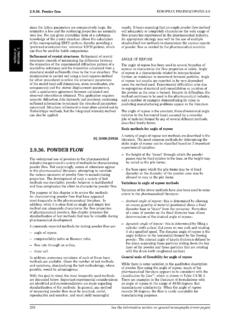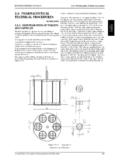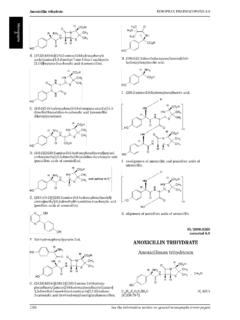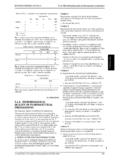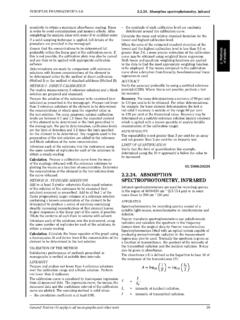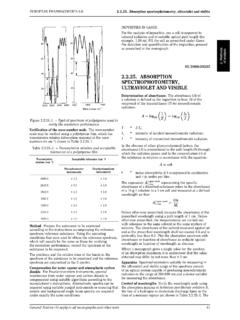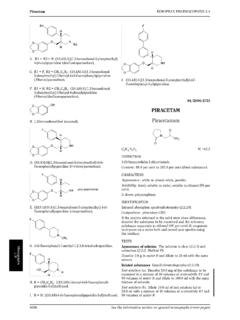Transcription of LACTOSE MONOHYDRATE - uspbpep.com
1 EUROPEAN PHARMACOPOEIA monohydrateBulkandtappeddensity( ). Determine the bulkdensity and the tapped density. Calculate the Hausner indexusing the following expression:V0=volume of bulk substance,Vf=volume of tapped substance. - LACTOSE and ( ).Silylation Rand 72 volumes ofpyridine solution. Dissolve about 1 mg of the substance to beexamined in ml ofdimethyl sulphoxide the silylation reagent. Mix gently and allow to stand for20 solution. Prepare a mixture of -lactosemonohydrate Rand - LACTOSE Rhaving an anomeric ratio ofabout 1:1 based on the labelled anomeric contents of the - LACTOSE MONOHYDRATE and - LACTOSE . Dissolve about 1 mgof this mixture in ml ofdimethyl sulphoxide ml of the silylation reagent. Mix gently and allow tostand for 20 : material: glass, size:l= , =4mm, stationary phase:silanised diatomaceous earth for gaschromatography Rimpregnated with 3 per centm/mofpoly[(cyanopropyl)(methyl)][(ph enyl)(methyl)]siloxane gas:helium for chromatography rate:40 : column:215 C, injection port and detector:275 :2 suitability: reference solution: relative retentionwith reference to - LACTOSE : - LACTOSE = about , resolution: minimum between the peaks due to - LACTOSE and the percentage content of - LACTOSE from theexpression:Calculate the percentage content of - LACTOSE from theexpression:Sa=area of the peak due to - LACTOSE ,Sb=area of the peak due to on drying( ).
2 Determine on g by dryingin an oven at 80 C for 2 :0187 LACTOSE MONOHYDRATEL actosum monohydricumC12H22O11, MONOHYDRATE is the MONOHYDRATE ofO- -D-galactopyranosyl-(1 4)- white or almost white, crystalline powder, freely but slowlysoluble in water, practically insoluble in ethanol (96 percent).IDENTIFICATIONF irst identification: A, identification: B, C, Examine by infrared absorption spectrophotometry( ), comparing with the spectrum obtained withlactose Examine by thin-layer chromatography ( ), usingaTLC silica gel G plate solution. Dissolve 10 mg of the substance to beexamined in a mixture of 2 volumes ofwater Rand3 volumes ofmethanol Rand dilute to 20 ml with thesame mixture of solution (a). Dissolve 10 mg oflactose CRSin a mixture of 2 volumes ofwater Rand 3 volumes ofmethanol Rand dilute to 20 ml with the same mixtureof solution (b).Dissolve10mgeachoffructose CRS,glucose CRS, LACTOSE CRSandsucrose CRSin a mixture of 2 volumes ofwater Rand3 volumes ofmethanol Rand dilute to 20 ml with thesame mixture of separately to the plate 2 l of each solution andthoroughly dry the starting points.
3 Develop over a pathof 15 cm using a mixture of 10 volumes ofwater R,15 volumes ofmethanol R, 25 volumes ofglacial aceticacid Rand 50 volumes ofethylene chloride R,measuredaccurately since a slight excess of water producescloudiness. Dry the plate in a current of warm air. Repeatthe development immediately, after renewing the mobilephase. Dry the plate in a current of warm air and sprayevenly with a solution of g ofthymol Rin a mixtureof 5 ml ofsulphuric acid Rand 95 ml ofalcohol at 130 C for 10 min. The principal spot in thechromatogram obtained with the test solution is similarin position, colour and size to the principal spot in thechromatogram obtained with reference solution (a). Thetest is not valid unless the chromatogram obtained withreference solution (b) shows 4 clearly separated (1)applytoallmonographsandothertexts1887 LactuloseEUROPEAN PHARMACOPOEIA Dissolve g in 5 ml ofwater Rand heat in a water-bath at 80 C for 10 min. A red It complies with the test for water (see Tests).
4 TESTSA ppearance of solution. Dissolve g in boilingwater R,dilute to 10 ml with the same solvent. The solution is clear( ) and not more intensely coloured than referencesolution BY7( , Method II).Acidity or alkalinity. Dissolve g by heating in 25 mlofcarbon dioxide-free water R, cool and add ml ofphenolphthalein solution R. The solution is colourless. Notmore than ml M sodium hydroxideis required tochange the colour of the indicator to optical rotation( ). Dissolve g in 80 ml ofwater R, heating to 50 C. Allow to cool and add ml ofdilute ammonia R1. Allow to stand for 30 min and diluteto ml withwater R. The specific optical rotation is+ to + , calculated with reference to the ( ). Dissolve g in boilingwater Rand dilute to ml with the same solvent (solution A).The absorbance of the solution measured at 400 nm is notgreater than Dilute ml of solution A to ml withwater R. Examine the solution from 210 nm to 300 nm. Atwavelengths from 210 nm to 220 nm, the absorbance is notgreater than At wavelengths from 270 nm to 300 nm,the absorbance is not greater than metals( ).
5 Dissolve g inwater Rwithwarming, add 1 ml M hydrochloric acidand diluteto 20 ml withwater R. 12 ml of the solution complies withlimit test A for heavy metals (5 ppm). Prepare the referencesolution usinglead standard solution (1 ppm Pb) ( ): per cent to per cent, determinedon g by the semi-micro determination of water, usinga mixture of 1 volume offormamide Rand 2 volumes ofmethanol Ras the acid R, evaporate to dryness on a water-bathand ignite to constant contamination. Total viable aerobic count ( )not more than 102micro-organisms per gram, determinedby plate-count. It complies with the test forEscherichiacoli( ).STORAGEIn an airtight CHARACTERISTICSThe following test are not mandatory requirements but inview of their known importance for achieving consistencyin manufacture, quality and performance of medicinalproducts, it is recommended that suppliers should verifythese characteristics and provide information on the below have been found suitable however, othermethods may be MONOHYDRATE is predominantly used as afiller/diluent in solid dosage forms (compressed andpowder).
6 The following characteristics are relevant for thistype of size distribution. Determine by laser diffractionor sieve and tapped density( ). Determine the bulkdensity and the tapped density. Calculate the Hausner Indexusing the following expression:V0=volume of bulk substance,Vf=volume of tapped contains not less than per cent andnot more than the equivalent of per cent of4-O-( -D-galactopyranosyl)-D-arabino-hex-2-ulo furanose,calculated with reference to the anhydrous white or almost white, crystalline powder, freely solublein water, sparingly soluble in methanol, practically insolublein melts at about 168 identification: B, C, D, :A,C,D, Examine by thin-layer chromatography ( ), usingsilica gel G Ras the coating solution. Dissolve mg of the substance to beexamined inwater Rand dilute to ml with the solution. Dissolve mg oflactulose CRSinwater Rand dilute to ml with the same separately to the plate 2 l of each over a path of 15 cm using a mixture of10 volumes ofglacial acetic acid R, 15 volumes of a50 g/l solution ofboric acid R, 20 volumes ofmethanol Rand 55 volumes ofethyl acetate a g/l solution of1,3-dihydroxynaphthalene Rin a mixture of 10 volumes ofsulphuric acid Rand90 volumes ofmethanol R.
7 Heat the plate at 110 C for5 min. The principal spot in the chromatogram obtainedwith the test solution is similar in position, colour andsize to the principal spot in the chromatogram obtainedwith the reference the information section on general monographs (cover pages)

